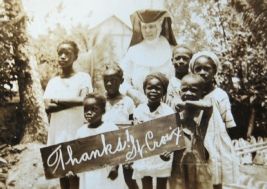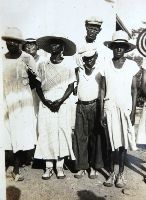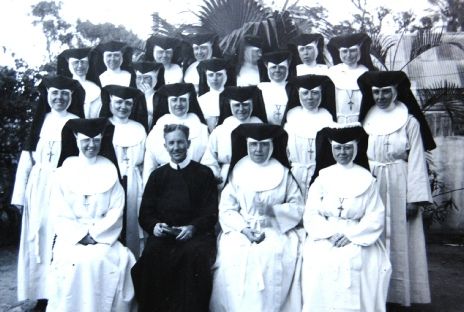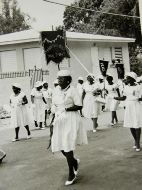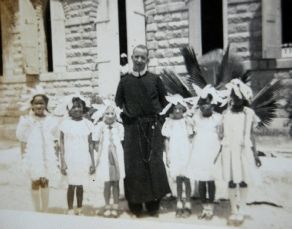Parish History
Catholicism came to St. Croix through the efforts of Mr. Nicholas Tuite, the owner of Sion Estate, a large sugar plantation in the middle of the island. Born on the English island of Montserrat to Irish Catholic parents, he moved to St. Croix because of difficulties practicing his faith under the British government on Montserrat. On September 18, 1752, he petitioned Propaganda Fide, the missionary arm of the Holy See in Rome, "to name and depute one or two missionaries to found a Mission in the Island of St. Croix." The Propaganda Fide agreed to his request.
But Tuite still needed government permission. Many of the imported farmers were Catholic and Tuite requested the Lutheran governor to grant freedom of worship for the Catholic plantation workers. By decree dated September 20, 1754, the King of Denmark "grants that the Papists on St. Croix, St. Thomas and St. John practice freely their religion, build as many churches and have as many priests (but no Jesuits) as may be necessary." Such a liberal governmental permission was unprecedented, but St. Croix desperately needed colonists, and it led to a steady increase in Catholics from immigration and through conversions of the black slaves. The Catholic church was coming back to life. Since that time St. Croix has had a Catholic community. A church was soon built in Christiansted, and another built in Frederiksted.
Problems did not end there. The Holy Father was aware of the spiritual needs of the Virgin Islands and over the years priests were sent, especially from Ireland and various religious orders. But it was very difficult to keep priests on St. Croix because of the great poverty of the people. Also many priests died of infectious diseases within months of arriving here. A number of very young priests are buried in St. Patrick parish cemetery.
Finally Providence acted. Father Timothy O'Ryan, a very zealous pastor, was sent. When he arrived, the parish was without a church, a school and few parish organizations. The spiritual condition of so many scattered parishioners was terrible. On the rare occasion when they did have Mass, it was in a home. He was able to bring the parishioners together and then erected the present church building on part of the old cemetery. In 1844, the cornerstone was laid, and on June 15, 1846, Bishop Richard Smith, bishop of Port of Spain, consecrated the new church. Father Butler, pastor of Holy Cross Church, preached on the grand occasion, the biggest gathering of people on St. Croix up until that time.
Above the main entrance of the Church, there is a marble stone worn smooth by the winds and the rain. It reads:
"Dedication of St. Patrick by
the Right Rev. Dr.. Richard Smith, Bishop, on the 23rd of June, 1844,
and erected principally by the parishioners; under the auspices of the Rev. T. A. O'Ryan, pastor, June 15, 1846.
After building the church, Father O'Ryan began St. Patrick's school, with classes only on Saturday, but he ran into opposition from the Danish government and the school was soon closed. He also built the wall around the church yard. Because Father O'Ryan was so zealous and apostolic in administering the parish, his enthusiasm trickled down to the parishioners. There was new life at St. Patrick's.
In 1848, ideas of nationalism spread throughout Europe and revolutions touched France, Italy, Germany and Austria. It even touched the island of St. Croix. The slaves from the sugar estates rebelled. Father O'Ryan played a prominent role in both securing emancipation as well as calming the revolt. Governor Peter Von Scholten granted freedom to St. Croix's seventeen thousand slaves on July 3, 1848. The church bell in the south tower of St. Patrick's church rang out for freedom that day.
Father Michael Naughten, ordained in Ireland in 1858, was assigned to St. Patrick's on September 14, 1862, taking firm command of the parish. He broke ground and blessed the cornerstone of St. Patrick's school. It was opened to its first students on May 1,1866. The entire building cost $1,993. Since then, the children of Frederiksted have always had the wonderful gift of St. Patrick' s school.
The year 1867 was a bad one for St. Croix. In April the island was devastated by a hurricane. In October a second, more severe hurricane swept over the island and on November 18, 1867, a devastating earthquake and tidal wave hit at three o'clock in the afternoon, destroying many of the homes. The water covered the churchyard with two feet of water. Praise God that only fifteen people lost their lives. Then in 1876, a terrible hurricane struck the island, destroying part of the wall around the churchyard, but the new church and school stood strong.
In 1878, Father Michael Naughten was appointed successor to Bishop Poirier as fourth Bishop of Roseau. He served as Bishop for twenty years.
"The Mothers" - the I.C.M. Sisters.
The Missionary Canonesses of St. Augustine were founded in 1897 in India by Mother Marie Louise DeMeester. Mother Marie Louise herself led the first group of the Canonesses of St. Augustine, now known as the I.C.M. Sisters, arriving at Frederiksted dock on July 9, 1914, just seventeen years after their founding. It was the first expansion of their missionary services into the Caribbean. They opened classes in October to two hundred and eighty one students. Enrollment increased and many new textbooks, blackboards and desks were added to the school. Everyone was delighted with the progress of the children. The Canonesses were extremely dedicated, and some of them never left St. Croix for over twenty five years.
The Redemptorists
The Redemptorist priests and brothers have staffed St. Patrick since their arrival on Feb 28, 1918 - almost one year after the United States purchased the Virgin Islands from Denmark for $25 million dollars.
1937 saw a total renovation of St. Patrick Church after a devastating fire two years earlier. The sanctuary was redone and the shrines of Our Lady of Perpetual Help and St. Alphonsus were newly erected in the sanctuary. In 1942 the school building was erected and stands proudly to this day.
On January 12, 1972, work was begun on restoring St. Patrick's church. Under the direction of Father Robert Gaugler, C.Ss.R., and Father Lawrence Buckley, pastor, the renovation exposed the magnificent coral stone bricks of 1846 as well as the church's rich Caribbean heritage and beauty. The total cost of renovation was $114,655. St. Patrick's was rededicated on March 12, 1972 by Bishop Harper, the first bishop of the Diocese of St. Thomas.
Hurricane Hugo of September 18, 1989. was the most powerful hurricane to hit St. Croix (and the U.S. Virgin Islands) in this century. Winds were well over 200 mph. The devastation was enormous. People were months without power and running water. Repairs on property took a long time to finish. St. Patrick Church lost its roof which was replaced by the Pastor, Fr. Thomas O'Connor. That was the last major renovation to the Church up to the present time.

